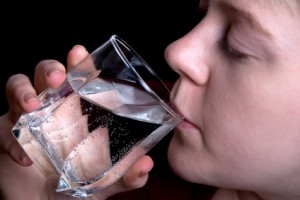 A human can only survive three days without water. The number one ingredient in a human body? Water – over 70%. Human health depends on an adequate supply of clean drinking water. In 1990, 1.1 billion people did not have access to safe drinking water, mostly in underdeveloped nations (1).
A human can only survive three days without water. The number one ingredient in a human body? Water – over 70%. Human health depends on an adequate supply of clean drinking water. In 1990, 1.1 billion people did not have access to safe drinking water, mostly in underdeveloped nations (1).
On this page, we deal with these issues related to drinking water:
Clean drinking water is something that some Manitobans may take for granted. It isn’t surprising. Manitoba has thousands of freshwater lakes, some so pristine you can take a drink right from your canoe. Climate change will have a profound impact on freshwater supply and quality in Manitoba, and around the world (2).
Not enough water
Summer temperatures in Manitoba are predicted to rise by 3 to 4ºC (3). Such conditions will increase the rate of evaporation, lowering lake and river levels, and soil moisture content. With reduced water volume, the concentration of pathogens, pesticides and other pollutants will rise above current values. In some regions, current values already exceed Canadian health standards (4). In Alberta, the amount of biological waste produced by cattle and hogs is equal to that of 87 million people (5).
Canada’s agricultural regions should expect a reduction in summer precipitation. Declines of up to 10% to 20% are forecasted for Manitoba’s south-west resulting in summer drought conditions (6). Already, flows in the major rivers of the western prairies have been reduced to 20-70% of their historic flows as a result of climate warming and overuse (7).
Too much water
With climate change, more heavy rainfall events, thunderstorms and hailstorms due to increased evaporation and convection are predicted. Springtime precipitation is expected to increase by 20% across the Prairies (8). And with it, more flooding and surface runoff, putting drinking water in danger.
Floodwaters and stormwaters can carry 1000 times the normal amount of disease-bearing microorganisms, as well as pesticides, metals and other pollutants (9). There are over 120 types of viruses from human and animal waste that can be spread through water, including insulin-dependent diabetes and meningitis (10). Heavy rainfall, runoff and flooding have been associated with individual outbreaks of waterborne diseases the world over (11).
Outbreaks are not limited to countries with poor sanitation systems. In developed nations, heavy rains overburden water treatment facilities and sewage systems. With spillovers of raw sewage, animals waste from farms, and other pollutants, high levels of enteric pathogens are released into local water supplies.
In 1993, an estimated 403 000 people fell ill and 54 people died of cryptosporidosis in Milwaukee, Wisconsin (12). The outbreak was preceded by a period of heavy rainfall and highly turbid runoff that overloaded water treatment plants.
The list of potential health hazards resulting from floodwater is long:
| Type of Hazard | Environmental Effect | Specific Dangers |
|---|---|---|
| Chemical hazards from |
||
| dumping grounds | water-bourne illness | bacterial diseases |
| pesticides | contamination of soil | viral diseases |
| gas stations | parasites | |
| graveyards | acute poisoning | |
| human and animal waste | accumulation of pollutants into plants and animals (food chain) | accumulation of pollutants in humans |
| Biological hazards from |
||
| mosquitos | increased pest populations | vector-borne disease |
| rodents | seek shelter and come into contact with humans | pest-related damage |
| other wild animals | animal bites | |
| Physical hazards from |
||
| swiftly flowing water | road wash-outs | car accidents |
| destabilized buildings | building collapse | |
| dangerous currents | drownings | |
Table 1: Health hazards associated with floodwaters (13).
Groundwater
About one third of Manitobans rely on groundwater as a source of drinking water. However, rural water supplies are especially at risk of contamination. Agricultural waste, including pesticides, bacteria, parasites, and nitrates are pollutants that commonly find their way into groundwater. Waterborne illnesses are troublingly common in Prairie Provinces compared with national rates (14).
In 1994, Manitoba accounted for 31% of all hepatitis A cases in Canada, but with only 4% of the population (15).
The incidence of bacteria from Canadian well water has doubled in the past 45 years (16). In 1993, 37% of Manitoba farms were contaminated with bacteria from animal manure (17). Once in groundwater supplies, bacteria are able to survive and multiply for several months. Common bacterial pathogens such as E. coli and Crypsotsporidium are carried by cattle and sheep who may show no signs of illness. Pigs, chickens and cattle can carry Salmonella (18).
Climate change models predict increased heavy precipitation events in Manitoba. Without more runoff, more agricultural pollutants will find their way into aquifers, wells and drinking water.
Under-reporting illness
The role of water quality in outbreaks is often overlooked and under-reported. Some waterborne diseases such as salmonellosis, campylobacteriosis and giardiasis can cause only mild discomfort in healthy individuals (19). Many do not seek medical attention, dismissing the symptoms as food poisoning or stomach flu.
The link between climate-mediated water contamination and outbreaks is easy to miss. A two-month lag is typical between heavy rainfall and the detection of groundwater contamination (20). One month usually passes before dirtied surface water causes widespread illness (21).




